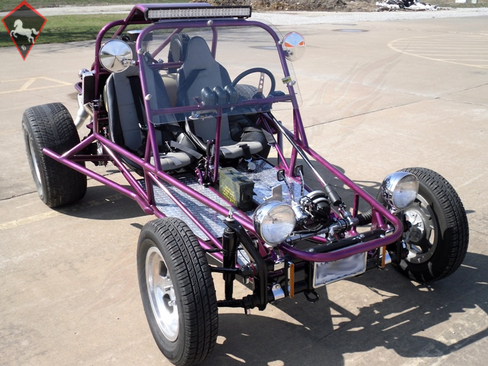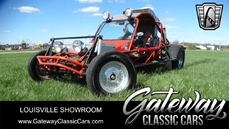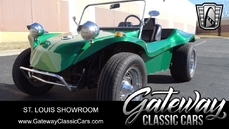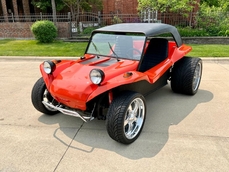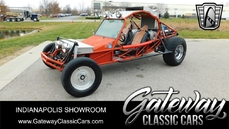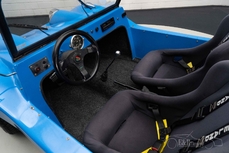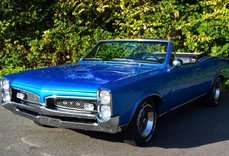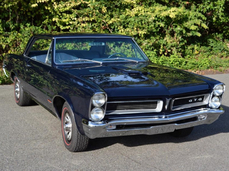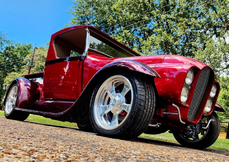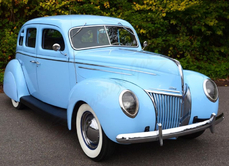Volkswagen Beach Buggy 1915 cc 1973
General description :
1973 Volkswagen Sand Rail Custom A Sand Rail is a light weight off road specialty vehicle designed for their ability to sail across sand dunes with ease. They are often mistakenly called dune buggys and although there are similarities, Sand Rails typically have no body panels or doors and have a low center of gravity allowing it to take tight turns even on sand. They also have a tubular design and integrated roll cage. They were kept pretty basic being mainly composed of the frame, engine, transmission, wheels and a couple seats. This very well built 1973 VW Sand Rail utilizes a ton of high quality components. While it can handle the sand no problem this one was also built to be street legal. We have seen some of these before that really aren't ideal on the street but this one can zip around nicely. The frame/body is painted in a Candy Purple paint that has a great shine. It has nice chrome headlights and an overhead light bar. It rides on custom wheels with Hoosier Pro Street rear tires. The rear mounted engine is a Volkswagen 1915cc motor that is basically all new from top to bottom and heavily modified. Nothing is stock. It has an Eaton m-62 supercharger that is fully ported and makes 22 pounds of boost. It is all balanced and fitted with a Scat counter weight forged crank, forged rods, forged pistons, 44x37.5 gtv head CB turbo springs, Steve long custom grind blower cam, forged rocker arms, chromoly push rods, Holley 750 cfm blower carb, a deep sump oil pan, and a full flow oil external cooler. It also has 4 custom fan blowers and cooling tins with 2 on each side. The freshly built swing rhino case super differential was just done by B&D Performance and it has Wedel gears, a 300m input shaft, hydraulic clutch, billet flywheel and 3 stage Kennedy pressure plate. This Sand Rail is very quick with lots of power. With a focus on performance the cockpit has been kept fairly simple with diamond plate floors and dual Black/Gray high back seats with 5 point safety harnesses. To the center of what would be considered the dash is all of your gauges and the control panel. It has a GPS Speedometer and the controls include a push button start as well as toggle switches for the ignition, oil cooler fan, fuel pump, driving lights, head lights, top light bar, horn, lower fans, and upper fans. Up by the nose a tachometer with shift light, boost gauge, and oil pressure gauge have been added. It was reported by the previous owner that over $40,000 was invested so if you are ready to have some fun in a Sand Rail here is an opportunity to get one at a fraction of the build cost and without having to go through the build trouble yourself. It's all yours for NOW REDUCED DOWN TO $15,000.00! This car is located in Clinton, Missouri.
1973 Volkswagen Beach Buggy 1915 cc is listed for sale on ClassicDigest in Arlington by Cris & Sherry Lofgren for $15000.
Car Facts
Car type : Car Make : Volkswagen Model : Beach Buggy Model Version : 1915 cc Engine size : 0.0 Model Year : 1973 Location : Arlington Vehicle Registration : Undefined
15000 $
People who viewed this Volkswagen Beach Buggy also viewed similar Volkswagen listed at ClassicDigest
Other cars listed for sale by this dealer
About Volkswagen
The Volkswagen story is indeed an intriguing tale of innovation, resilience, and post-war revival, marked by various models that have become iconic in automotive history.The People's Car (Volkswagen): Initially envisioned by Adolf Hitler in the 1930s as a "people's car" or "Volkswagen" in German, the idea was to create an affordable and practical vehicle for the German people. This concept led to the development of the Volkswagen Beetle (or the Type 1), designed by Ferdinand Porsche.
Post-War Challenges: After World War II, Volkswagen faced significant challenges. The factory was heavily damaged, and the brand's association with the Nazi regime led to a lack of interest in the car in some regions.
British Intervention - The British Army & Ivan Hirst: The British Army took control of the factory in the immediate post-war period. Major Ivan Hirst, a British Army officer, played a crucial role in reviving Volkswagen. He recognized the potential of the Beetle and advocated for its production, convincing the British military to order several thousand cars. This decision helped jumpstart the brand's revival.
Export Success and the Beetle's Global Appeal: The Beetle gained popularity not only in Germany but also globally, becoming an icon of affordable motoring. Its simple, reliable design and unique appearance made it a favorite among consumers worldwide.
Model Evolution: Over the years, Volkswagen introduced various models alongside the Beetle, each contributing to the brand's growth:
Type 2 (VW Bus or Transporter): Introduced in the 1950s, it became an iconic symbol of the hippie movement in the 1960s, loved for its spaciousness and versatility.
Golf (Rabbit in the U.S.): Launched in the mid-1970s, the Golf (or Rabbit in the U.S.) marked a shift towards front-wheel-drive, modern design, and hatchback practicality, becoming a cornerstone of the brand's success.
Passat, Jetta, and Other Models: Volkswagen expanded its lineup with models like the Passat and Jetta, catering to different market segments.
Challenges and Innovations: Despite success, Volkswagen faced challenges, including quality issues in the 1970s. However, the brand continued to innovate and develop new models and technologies.
Rise of the GTI and Global Expansion: The 1980s saw the rise of the iconic Golf GTI, a high-performance version that sparked the hot hatch trend. Volkswagen also expanded its global presence during this period.
The British intervention in reviving Volkswagen after World War II played a pivotal role in the brand's resurgence. While there might have been some tensions or competition among automotive companies in the 1950s and 1960s due to Volkswagen's post-war success, the brand's ability to produce innovative and popular models solidified its place in automotive history.
